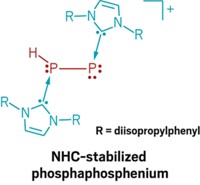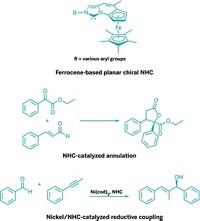Advertisement
Grab your lab coat. Let's get started
Welcome!
Welcome!
Create an account below to get 6 C&EN articles per month, receive newsletters and more - all free.
It seems this is your first time logging in online. Please enter the following information to continue.
As an ACS member you automatically get access to this site. All we need is few more details to create your reading experience.
Not you? Sign in with a different account.
Not you? Sign in with a different account.
ERROR 1
ERROR 1
ERROR 2
ERROR 2
ERROR 2
ERROR 2
ERROR 2
Password and Confirm password must match.
If you have an ACS member number, please enter it here so we can link this account to your membership. (optional)
ERROR 2
ACS values your privacy. By submitting your information, you are gaining access to C&EN and subscribing to our weekly newsletter. We use the information you provide to make your reading experience better, and we will never sell your data to third party members.
Synthesis
Fluoroalkoxy Carbenes Prepared
Novel ligand system combining two versatile moieties may open up unexplored territory in catalysis
by Craig Bettenhausen
May 6, 2013
| A version of this story appeared in
Volume 91, Issue 18
A new ligand family formed by combining two types of compounds with unusual functional groups could lead to a range of previously inaccessible organometallic transition-metal catalysts. N-Heterocyclic carbenes (NHCs) have been go-to ligands for preparing transition-metal catalysts since Anthony J. Arduengo III stabilized those reactive species in the 1990s. Now Arduengo and Jason W. Runyon of the University of Alabama, DuPont chemist Viacheslav A. Petrov, and coworkers have modified a series of NHCs by attaching bis(trifluoromethyl) alkoxy groups (shown in blue). The fluorine-heavy electron-withdrawing substituents were previously used by the University of Illinois’ James C. Martin to study main-group elements in unusual coordination environments. But Martin’s ligands did not effectively bind transition metals. The Alabama-DuPont team prepared the new combo ligands as zwitterions in a one-pot high-yield reaction (Angew. Chem. Int. Ed., DOI: 10.1002/anie.201301503). They treated the zwitterions with strong base to generate transient carbenes, which they observed via NMR spectroscopy. By adding a nickel salt, the group was able to crystallize the organometallic carbene complex shown. The group has also prepared related Fe, Ta, Ti, Ru, and W complexes, and catalytic studies are under way. “We anticipate this ligand system will find application in catalysis for metals not usually suitable for catalysis,” Arduengo says.





Join the conversation
Contact the reporter
Submit a Letter to the Editor for publication
Engage with us on Twitter